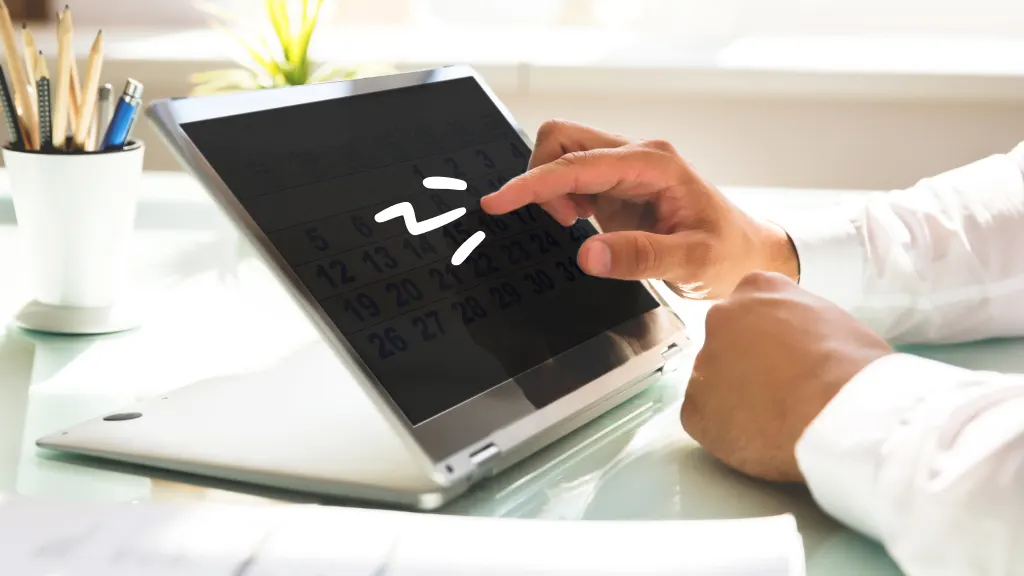HP laptop touch screen not working? Here's what to do

Touch screens are one of the most convenient features of modern HP® laptops. They make navigation faster, efficient, intuitive, and often more fun—until they stop working. Suddenly, dragging, swiping, tapping, and scrolling turn into frustrating tasks.
At Asurion, we're the tech experts you can trust—each year, more than 30 million people rely on us to keep their tech running. So whether your screen is sporadically unresponsive or completely non-functional, our solutions will get your touch screen back to its smooth, responsive self.
Why is my HP touch screen not working?
First, identify potential causes for your HP laptop's touch screen not working. Here are some of the most common reasons it might be acting up:
- Physical damage. Even small cracks or scratches can prevent your touch screen from working properly. If you spot any damage, your best bet is to bring your laptop to an HP repair expert for assessment and repair.
- Disabled touch screen settings. Sometimes, users can switch off touch screen settings by mistake. This issue is one of the quickest to fix.
- Driver problems. Outdated or corrupted drivers are a primary cause of touch screen functionality issues.
- Software hitches. Old Windows® versions or unsupported settings may cause problems.
- Calibration issues. If your touch screen is unresponsive or detects incorrect taps, it may need reconfiguration.
Now that you understand the main reasons, learn solutions to breathe life back into your touch screen.
Before you begin
To make troubleshooting more efficient, do some prep work:
- Connect your laptop to a reliable power source: Troubleshooting often requires considerable power. Some hardware checks or updates may fail if the battery level is low.
- Have a strong internet connection: Many troubleshooting steps need quick access to online resources. This includes downloading drivers or updates without interruption.
- Clean your screen: Use a microfiber cloth to avoid scratching the display. It will remove any debris that could hamper touch sensitivity.
- Disconnect external devices: Unplug any devices that could affect the touchscreen. Examples include USB drives or extra monitors.
Troubleshooting HP touch screen issues
Now you’re prepared and understand some of the underlying issues, let’s take a look at some steps you can try to solve the problem.
Enable the touch screen
Sometimes, the solution is as simple as re-enabling your touchscreen.
- Search for Device Manager in the Windows search bar and select it.
- Expand the Human Interface Devices section.
- Look for HID-compliant touch screen in the list.
- Right-click on it and select Enable device. If you don’t see the option, it may already be enabled.
- Restart your laptop to apply the changes.
Tap or swipe on your screen to see if it responds. If it doesn't react, try restarting your computer.
Restart your laptop
It may sound simple, but restarting can often resolve temporary glitches.
- Click on the Start menu.
- Select Power, then choose Restart.
- After rebooting, tap or swipe the screen to test responsiveness.
Recalibrate the touch screen
If your issue with your HP touch screen laptop not working involves faulty taps or erratic behavior, recalibration can help improve responsiveness.
- Search for Control Panel in the Windows search bar and select it.
- Select Hardware and Sound and then click on Tablet PC Settings.
- Under the Display tab, click on Calibrate. If you have multiple screens, ensure the correct one is selected.
- Follow the on-screen instructions by tapping the crosshairs as they appear.
- Select OK or Apply to save your changes.
If the problem remains, it's time to update your drivers.
Update touch screen drivers
Outdated or corrupted drivers often cause touch screen malfunctions. When you update your drivers, your HP touch screen becomes compatible with the latest operating system updates.
- Search for Device Manager in the Windows search bar and select it from the results.
- Expand the Human Interface Devices section.
- Right-click on HID-compliant touch screen, select Update driver, and choose Search automatically for drivers.
- After the driver update completes, restart your laptop to apply the changes.
This process should install any missing updates for your touchscreen. Once it's complete, restart your laptop to see if the problem continues.
If Windows can’t find updates or you need a specific version, visit the HP support website to download compatible drivers.
Run Windows Troubleshooter
The built-in Windows Troubleshooter helps find and fix touch screen software issues.
- Search for Troubleshoot Settings in the Start menu.
- Click on Additional Troubleshooters (or something similar, depending on your Windows version).
- Under the Find and Fix Other Problems section, select Hardware and Devices. Click Run the Troubleshooter.
- Follow the on-screen instructions to complete the process.
If you've tried these steps and still need a little help, we're right around the corner. Schedule a repair at the nearest uBreakiFix® by Asurion store and our certified experts can get your device back up and running as soon as the same day.
The Asurion® trademarks and logos are the property of Asurion, LLC. All rights reserved. All other trademarks are the property of their respective owners. Asurion is not affiliated with, sponsored by, or endorsed by any of the respective owners of the other trademarks appearing herein.